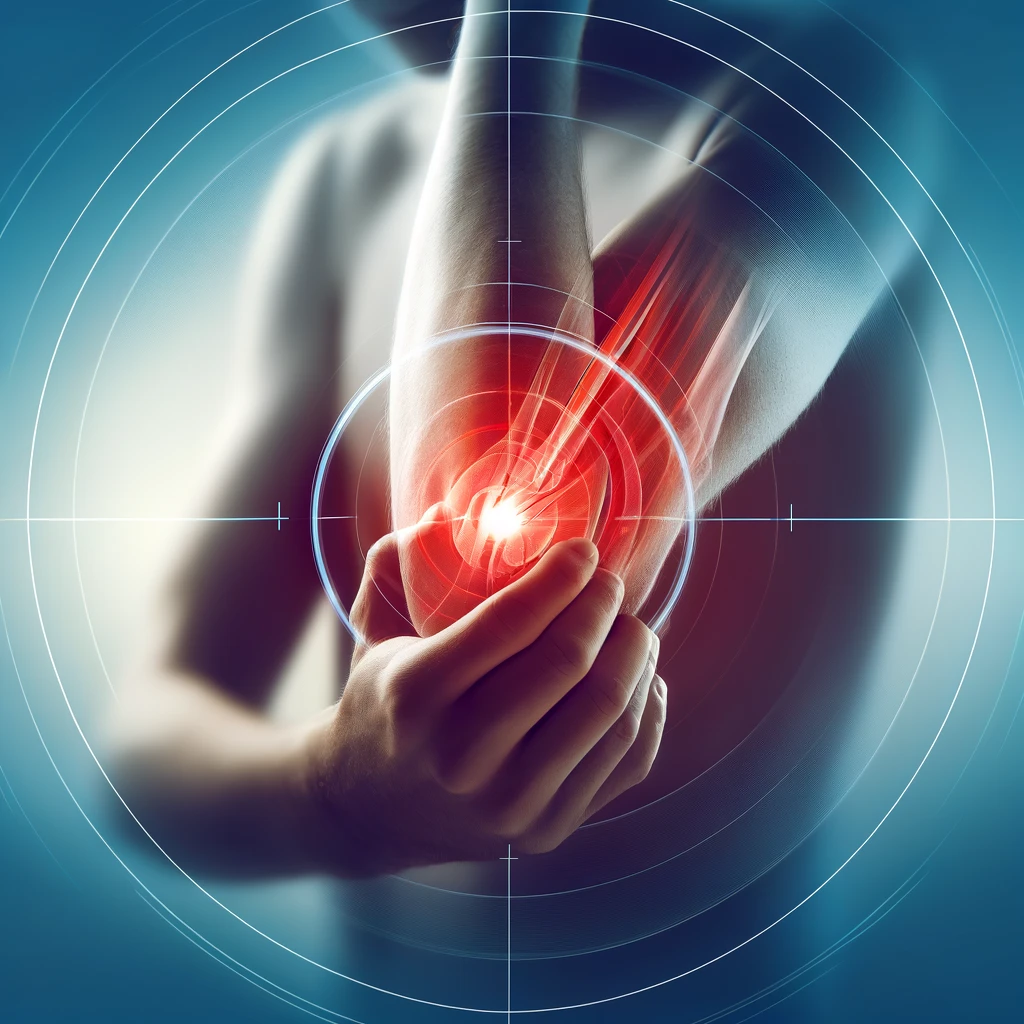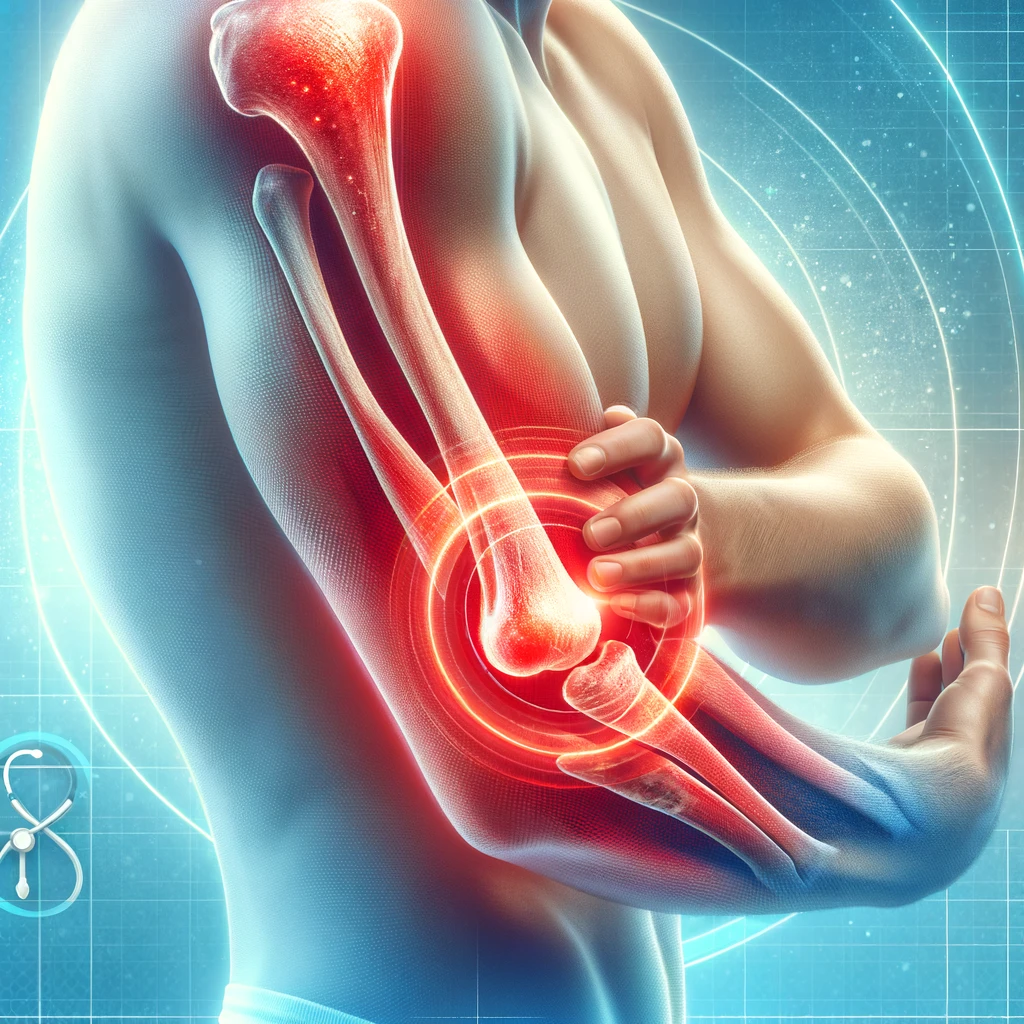
Table of Contents
Elbow pain can be incredibly disruptive, affecting everything from your work to your favorite hobbies. Whether you’re dealing with a sudden injury or chronic discomfort, finding the right treatments for elbow pain is key to getting back to your daily activities.
Types of Elbow Pain
Acute vs. Chronic Elbow Pain
Elbow pain can be categorized as acute or chronic. Acute pain often results from a specific injury, like a fall or sudden twist and is typically short-lived. Chronic pain, however, develops over time due to repetitive movements or underlying conditions and can persist for months or even years.
Common Causes: Overuse, Injury, Arthritis
The most common causes of elbow pain include overuse injuries like tennis elbow, traumatic injuries such as fractures or dislocations and conditions like arthritis which can cause long-term joint pain and inflammation.
Home Treatments for Elbow Pain
Rest and Activity Modification
Giving your elbow a break can be one of the most effective ways to alleviate pain. Modify your activities to avoid movements that exacerbate the pain, and take regular breaks to prevent further strain.
Ice and Heat Therapy
Applying ice packs to the elbow can help reduce inflammation and numb the pain. Heat therapy, such as using a warm compress or heating pad, can relax muscles and improve blood flow, aiding in the healing process. Alternating between ice and heat can provide balanced relief.
Compression and Elevation
Using a compression bandage can help manage swelling, while elevating the elbow above heart level can reduce fluid buildup and decrease pain.
Natural Treatments
Herbal Remedies
Herbs like turmeric and ginger are known for their anti-inflammatory properties. Incorporating these into your diet or taking them as supplements can help manage elbow pain naturally.
Essential Oils
Essential oils such as peppermint, eucalyptus, and lavender can be massaged into the elbow to provide relief. These oils have soothing and anti-inflammatory effects that can help reduce pain and improve mobility.
Dietary Changes
A diet rich in anti-inflammatory foods like fish, nuts, and leafy greens can help reduce overall inflammation in the body, potentially alleviating elbow pain.
Over-the-Counter Treatments
Pain Relievers
Non-prescription pain relievers like ibuprofen and acetaminophen can help manage pain and reduce inflammation in the elbow.
Anti-Inflammatory Medications
NSAIDs (nonsteroidal anti-inflammatory drugs) can be particularly effective in treating pain caused by inflammation. These can be found over-the-counter or prescribed by a doctor.
Topical Creams and Gels
Topical treatments such as creams and gels can be applied directly to the elbow for localized pain relief. Look for products containing ingredients like menthol or capsaicin for added effectiveness.
Physical Therapy and Exercises
Stretching Exercises
Stretching exercises can help maintain flexibility and reduce stiffness in the elbow. Gentle stretches that target the forearm and elbow muscles are particularly beneficial.
Strengthening Exercises
Strengthening exercises help support the elbow joint and prevent future injuries. Using light weights or resistance bands can help build muscle without overstraining the elbow.
Range of Motion Exercises
These exercises aim to improve the elbow’s flexibility and overall function. Regularly moving the joint through its full range of motion can prevent stiffness and improve mobility.
Alternative Therapies
Acupuncture
Acupuncture involves inserting thin needles into specific points on the body to relieve pain. It can be an effective treatment for chronic elbow pain, helping to reduce pain and improve function.
Massage Therapy
Massage therapy can help relax muscles, reduce tension, and improve blood flow. A professional massage therapist can target the elbow and surrounding areas to provide relief from pain.
Chiropractic Care
Chiropractic adjustments can help alleviate pain and improve joint function, especially if the pain is caused by misalignment or nerve compression.
Medical Treatments
Prescription Medications
For severe or persistent elbow pain, a doctor may prescribe stronger medications to help manage pain and inflammation.
Injections
Corticosteroid injections can reduce inflammation and provide significant pain relief for conditions like tennis elbow or arthritis.
Surgery
In cases where other treatments have failed, surgery may be necessary to repair damaged tissues or relieve nerve compression.
Lifestyle Changes
Ergonomic Adjustments
Making ergonomic adjustments at work and home can help prevent and alleviate elbow pain. This includes using proper posture, supportive equipment, and taking regular breaks.
Proper Technique in Activities
Using the correct technique in sports and other activities can help prevent overuse injuries. Professional training or coaching can ensure you’re performing movements correctly and safely.
Regular Exercise and Stretching
Regular exercise and stretching can keep your muscles strong and flexible, reducing the risk of injury and pain.
Preventive Measures
Warm-Up Routines
Warming up before physical activity can help prepare your muscles and joints, reducing the risk of injury.
Protective Gear
Using protective gear like elbow pads can help prevent injuries during sports and other activities.
Regular Breaks During Repetitive Activities
Taking regular breaks and changing positions during repetitive activities can help prevent overuse injuries and elbow pain.
When to See a Doctor
Signs That Require Medical Attention
If your elbow pain is severe, persistent, or accompanied by swelling, redness, or numbness, it’s important to seek medical attention. These symptoms could indicate a more serious condition.
Persistent or Severe Pain
Pain that doesn’t improve with home remedies or over-the-counter treatments should be evaluated by a healthcare professional.
Diagnostic Tests and Evaluations
A doctor may recommend imaging tests like X-rays or MRIs to diagnose the cause of your elbow pain accurately.
Living with Elbow Pain
Coping Strategies
Living with chronic elbow pain can be challenging. Finding effective coping strategies, such as gentle exercises, stress management techniques, and support from friends and family, is essential.
Support Systems
Joining a support group or seeking counseling can help you manage the emotional and psychological aspects of living with chronic pain.
Mental Health Considerations
Chronic pain can take a toll on your mental health. It’s important to address these issues with appropriate mental health support.
Expert Opinions
Insights from Healthcare Professionals
Healthcare professionals can provide valuable insights into the causes and treatments of elbow pain, as well as tips for prevention and management.
Tips from Physical Therapists
Physical therapists can offer advice on exercises and stretches to strengthen the muscles around the elbow and prevent pain.
Case Studies
Success Stories of Managing Elbow Pain
Hearing success stories from others who have managed their elbow pain can provide inspiration and practical tips.
Common Challenges and Solutions
Understanding common challenges and how others have overcome them can help you navigate your own journey with elbow pain.
Conclusion
Elbow pain can be managed effectively with the right approach. From home treatments and natural remedies to professional therapies and lifestyle changes, finding what works for you is key. Remember, if your pain persists or worsens, it’s important to seek medical advice.
FAQs
What are the first signs of elbow pain?
The first signs of elbow pain often include discomfort, tenderness and stiffness in the elbow joint, especially after repetitive use or injury.
Can elbow pain be a sign of something serious?
Yes, elbow pain can sometimes indicate a more serious condition like a fracture, infection or nerve compression. It’s important to seek medical advice if the pain is severe or persistent.
How long does it take for elbow pain to heal?
The healing time for elbow pain depends on the cause and severity of the condition. Minor injuries may heal in a few weeks, while more serious conditions could take months.
Are there specific exercises to prevent elbow pain?
Yes, exercises that strengthen the forearm and wrist muscles, improve flexibility and enhance overall arm strength can help prevent elbow pain.
What should I avoid if I have elbow pain?
If you have elbow pain, avoid activities that strain the elbow, such as lifting heavy objects, repetitive motions and any movements that exacerbate the pain.



